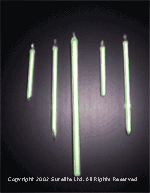 Tritium gas contained in small borosilicate glass tubes of various lengths |
Tritium is one of the "clean" sources of energy, being a "heavy" form of hydrogen (isotope symbol 3hydrogen or H3) around us all the time in the air. Described at a scientific level it is difficult for the non-expert to assess, but the following explanation of its practicalities is equally valid and perhaps more digestible.
For example, tritium irradiation cannot pass through the dead layer (cells) of one's skin. If tritium has entered by some other means (e.g. inhalation or ingestion, or by a wound) it is easily flushed from the body. Large liquid intake (3-4+ litres per day) reduces the effective half-life [existence] by a factor of 2 to 4. The energy (i.e. ability to travel) of the beta particle [electron] is very weak. By its own volition it can travel in air only one quarter of an inch: in water it is even less. The average person's involvement with tritium will be intermittent and transitory and not likely to produce contamination.
At the professional or institutional level of data, it is stated that tritium is the least radiotoxic of all nuclides. The amount of activity in tritiated water measures 0.064 mrem/microCuries of the tritium intake, and for organic compounds it is 0.16 mrem/microCuries of the tritium intake. No shielding is required because tritium is not an external radiation hazard. Assessment of intake is by urine bioassay. Liquid scintillation counting is the only readily available method for detecting it.
More detailed questions and answers about Tritium manufacture and control can be found on our Frequently Asked Questions page.